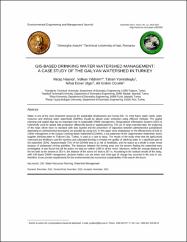| dc.contributor.author | Nişancı, Recep | |
| dc.contributor.author | Yıldırım, Volkan | |
| dc.contributor.author | Yomralıoğlu, Tahsin | |
| dc.contributor.author | Ülger, Nihat Enver | |
| dc.contributor.author | Özçelik, Ali Erdem | |
| dc.date.accessioned | 2020-12-19T19:56:22Z | |
| dc.date.available | 2020-12-19T19:56:22Z | |
| dc.date.issued | 2015 | |
| dc.identifier.citation | Nisanci, R., Yildirim, V., Yomralioglu, T., Ulger, N.E., Ozcelik, A.E. (2015). Gis-based drinking water watershed management: a case study of the galyan watershed in Turkey. Environmental Engineering and Management Journal, 14(12), 2919-2927. | en_US |
| dc.identifier.issn | 1582-9596 | |
| dc.identifier.issn | 1843-3707 | |
| dc.identifier.uri | https://hdl.handle.net/11436/2720 | |
| dc.description | WOS: 000369100100019 | en_US |
| dc.description.abstract | Water is one of the most important resources for sustainable development and human life. To meet future water needs, water resources and drinking water watersheds (DWWs) should be placed under protection using efficient methods. the spatial planning and spatial data has an important role in sustainable DWW management. Geographical Information Systems (GIS) is extensively used for spatial data production effectively based on spatial planning. the use of large-extended data, the analyzing of the maps which have no standard with data layered and the prevention of separation between administrative jurisdictions depending on administrative boundaries are possible by using GIS. in this paper since emphasized on the effectiveness of GIS in DWW management in the Galyan Drinking Water Watershed (GDWW), a sub-watershed of the Degirmendere Watershed, which supplies drinking water to Trabzon City, Turkey, is used as a case to study. the results of the study show that the agricultural chemicals and fertilizers used for hazelnut and cultivated farming to threaten the quality of drinking water in a significant part of the watershed (30%). Approximately 72% of the GDWW area is at risk of landslides, and the region as a whole is under threat because of widespread mining activities. the distances between the mining areas and the streams feeding the watershed were investigated. It was found that all the active ore beds are within 1,000 m of the rivers. Moreover, while the average distance of the ore beds to the streams is 253 m, the distance of the active ore beds is 357 m. According to the analysis results of the study, with GIS-based DWW management, decision makers can see where and what type of change has occurred in the area in use; therefore, it can provide requirements for the environmental and economical sustainability of the area in the future. | en_US |
| dc.language.iso | eng | en_US |
| dc.publisher | Gh Asachi Technical Univ Iasi | en_US |
| dc.rights | info:eu-repo/semantics/openAccess | en_US |
| dc.subject | GIS | en_US |
| dc.subject | Water Resources Planning | en_US |
| dc.subject | Watershed Management | en_US |
| dc.title | Gis-based drinking water watershed management: a case study of the galyan watershed in Turkey | en_US |
| dc.type | article | en_US |
| dc.contributor.department | RTEÜ, Mühendislik ve Mimarlık Fakültesi, Peyzaj Mimarlığı Bölümü | en_US |
| dc.contributor.institutionauthor | Özçelik, Ali Erdem | |
| dc.identifier.volume | 14 | en_US |
| dc.identifier.issue | 12 | en_US |
| dc.identifier.startpage | 2919 | en_US |
| dc.identifier.endpage | 2927 | en_US |
| dc.relation.journal | Environmental Engineering and Management Journal | en_US |
| dc.relation.publicationcategory | Makale - Uluslararası Hakemli Dergi - Kurum Öğretim Elemanı | en_US |


















